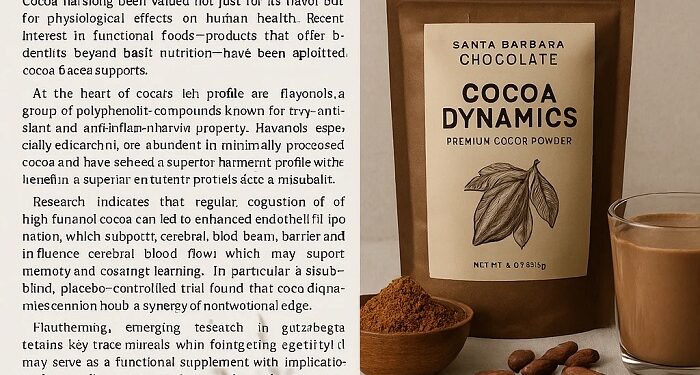Cocoa has long been valued not just for its flavor but for its physiological effects on human health. Recent interest in functional foods—products that offer benefits beyond basic nutrition—has spotlighted cocoa-based supplements such as Cocoa Dynamics by Santa Barbara Chocolate. While the product itself is a modern formulation, its potential benefits are rooted in centuries of traditional use and decades of scientific investigation.
At the heart of cocoa’s health profile are flavanols, a group of polyphenolic compounds known for their antioxidant and anti-inflammatory properties. Flavanols, especially epicatechin, are abundant in minimally processed cocoa and have been the subject of numerous clinical studies. Their ability to improve vascular function, reduce oxidative stress, and modulate inflammatory pathways underpins much of the interest in cocoa as a nutraceutical.
Research indicates that regular consumption of high-flavanol cocoa can lead to enhanced endothelial function, which supports healthy blood flow and blood pressure regulation. A study published in The American Journal of Clinical Nutrition demonstrated that participants who consumed flavanol-rich cocoa daily for several weeks exhibited significant improvements in flow-mediated dilation, a key marker of cardiovascular health.
The potential cognitive benefits of cocoa are also under investigation. Flavanols are believed to cross the blood-brain barrier and influence cerebral blood flow, which may support memory and learning. In particular, a double-blind, placebo-controlled trial found that older adults consuming high-flavanol cocoa performed better on tasks involving attention and memory than those receiving a low-flavanol placebo.
In addition to flavanols, Cocoa Dynamics likely retains key trace minerals found naturally in cacao, such as magnesium, iron, and potassium, which contribute to muscle function, oxygen transport, and electrolyte balance. The presence of theobromine, a mild stimulant, adds a metabolic and cognitive edge without the abrupt peaks associated with caffeine.
Importantly, the bioavailability of these compounds can be influenced by processing methods. Traditional alkalization (“Dutching”) significantly reduces flavanol content. Products like Cocoa Dynamics—if produced using low-temperature and minimal processing—may offer a superior nutrient profile compared to conventional cocoa powders.
Furthermore, emerging research in gut microbiota suggests that cocoa flavanols may act as prebiotics, selectively feeding beneficial bacteria such as Lactobacillus and Bifidobacterium. These microbial changes can have downstream effects on immune regulation and metabolic health.
From a nutritional science perspective, cocoa is more than just a treat—when formulated correctly, it may serve as a functional supplement with implications for cardiovascular, cognitive, and metabolic well-being. While no single food offers a cure-all, integrating compounds like those found in cocoa dynamics into a balanced diet can be a strategic approach to long-term health.
In summary, Santa Barbara Chocolate’s focus on high-integrity sourcing and minimal processing aligns with the scientific consensus on what makes cocoa effective from a wellness standpoint. The product’s potential lies in its synergy of naturally occurring bioactives—compounds that, when preserved in their original matrix, can provide meaningful physiological benefits backed by credible research.

































